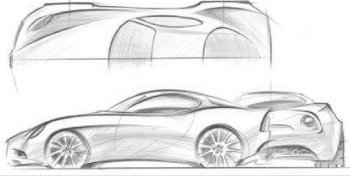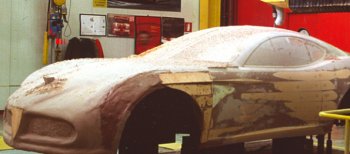|
|
 |
|
At ITCA the carbon fibre bodywork is meticulously mated
to the steel platform using the latest precision measuring equipment. |
|
 |
|
|
 |
Developed directly
from the show-stopping 8C Competizione concept car, which
made its debut at the 2003 Frankfurt IAA Motor Show, the
production version demonstrates the creativity and
engineering knowledge which is abundant at Alfa Romeo. |
|
|

 |
|
The 8C Competizione is a showcase of the talents prevalent at Alfa Romeo’s own
Centro Stile in Arese. Here an early clay mock-up is milled in 1:1 using a
5-axis milling machine. |
|
 |
|
|

 |
|
The Alfa 8C Competizione is the last in the line of thoroughbred
8-cylinder sports cars from Alfa Romeo. Here one of the many scale models used
for aerodynamic studies in the 1960s. |
|
|
|
The glorious Alfa
Romeo 8C Competizione is enjoying unparalleled media
attention, laying the foundations for a new chapter in
Alfa Romeo’s illustrious history as a producer of
thoroughbred sporting cars.
Devised as an
exclusive halo model for the modern Alfa Romeo range, the 8C
Competizione is now in production with first deliveries
already having been made.
Developed directly
from the show-stopping 8C Competizione concept car, which
made its debut at the 2003 Frankfurt IAA Motor Show, the
production version demonstrates the creativity and
engineering knowledge which is abundant at Alfa Romeo.
First and foremost
is the design, which caused such a stir when it was first
presented just over 4 years ago, and continues to impress to
this day. Created entirely by Alfa Romeo’s own Centro Stile
in Arese, the 8C Competizione’s voluptuous carbon-fibre
bodywork and luxurious sporting interior confirm the
uncompromising talent of the design team, now headed by top
designer Frank Stephenson.
The original design
of the 8C Competizione concept was refined in the Dallara
windtunnel, ensuring that the production car combined the
right balance of added downforce and low wind resistance.
For high-speed driving, the aerodynamicists achieved good
stability by elevating the rear end some 25mm. Additionally,
the shape of the 8C’s nose and the rear extractor also help
stick the car to the road and smooth the airflow.
The stunning
carbon-fibre bodywork is produced at ATR Group, a company
who also create carbon-fibre exterior and interior
components for Ferrari and Maserati, including special
series models such as the Ferrari Enzo and Maserati MC12. The
carbon-fibre body sections are then mated to the steel
chassis which is made by ITCA Produzione in Grugliasco, near
to the Fiat headquarters in Turin. Founded in 1951, ITCA has been supplying Ferrari since 1962, and now produce the
metal bodywork for Ferrari and Maserati production cars,
including the F430, 599, 612, Quattroporte and GranTurismo.
Although the 8C’s
carbon-fibre body and structure makes up 47% of the car’s
weight, using the die-pressed carbon-fibre for the body
instead of steel saved around 110kg of weight in the car,
including the added benefit of lowering the centre of
gravity. With a torsional stiffness measuring 24,000Nm/d,
the use of carbon-fibre also improved the 8C’s torsional and
flexural stiffness. This was also chosen to balance sporting
performance with feel. Other manufacturers such as Aston
Martin produce similar types of car with aluminium bodywork,
but Alfa Romeo debated that with a limited edition of just
500 units built roughly over one year, that carbon-fibre
would be better suited in order to respond quickly to
modifications rather than sheet metal technology.
The use of exotic
materials continues in the 8C’s luxurious interior. The
dashboard is also made from a single piece of carbon fibre,
sprinkled with uniquely-made aluminium switches, all of
which are beautifully detailed. A plaque on the centre
tunnel indicates that the car has a limited production run
of 500 examples. Upon request the plaque can also be
finished in silver and engraved with the production number
of the car and the name of the owner.
Just in front of the
plaque is another carbon fibre panel with a cluster of
switches controlling the cars dynamics and chassis setup.
Switches on this panel include the silver ‘Engine Start’
button and the electric handbrake, as well as the ‘Auto’
function to select automatic or manual gearing. Pressing the
‘Sport’ button activates four individual functions: a series
of baffles in the quad exhaust system are opened to produce
the trademark rorty “crackle and pop” Alfa 8C sound (a
favourite feature amongst the development engineers), the
throttle becomes more responsive, the traction control
becomes less intrusive and the gear shift times are halved
from 0,4 to 0,2 seconds. For more demanding drivers, a
separate button almost completely turns off the Vehicle
Dynamic Control (VDC) traction control, also resulting in a
faster clutch engagement.
Under the bonnet
lies the 90-degree V8 engine with a displacement of 4,691cc.
The engine was developed in conjunction with Maserati, and
was further tuned and refined by Alfa Romeo in order to
reach a maximum power output of 450bhp at 7,000rpm. Maximum
torque is 470 Nm at 4,750rpm.
The platform also
shares commonalities with Maserati, however the chassis has
more in common with the old Coupé / Spyder architecture than
that of the new GranTurismo / Quattroporte.
“Some industrial
cost sharing has been made between the GranTurismo and the
8C,” says Domenico Bagnasco, project leader for the 8C
Competizione. “The chassis of the 8C is made from steel,
like the GranTurismo, however the 8C has a highly modified
version with several new components. It is 500mm shorter in
length than the GranTurismo and the wheelbase is almost
300mm less, which makes it closer in size to the old Coupé. Differences in the
architecture mostly concentrate on the completely different
and new rear-end structure. The steel structure has been
altered from the mid-point of the floor right to the tail.”
Alfa Romeo continued
to use steel for its rear-collision robustness and for
easier installation of the robotized manual gearbox at the
back, unlike the GranTurismo which has a ZF torque converter
automatic at the front. The gearbox on the
8C Competizione is in fact an updated version of the
electronically actuated Graziano / Marelli six-speed manual
used in the original Maserati Coupé and Spyder, as well as
the first generation Quattroporte V.
In total the 8C
Competizione weighs 1,585kg (1,490kg dry weight) and has a
maximum speed in excess of 292 km/h. Engineers at Alfa Romeo
suggest that the car can easily top 300 km/h, whereas
acceleration from 0-100 km/h is achieved in under 4.2
seconds. Large Brembo brakes feature, with composite
dual-cast discs at both the front and rear measuring
360mm/32mm and 330mm/28mm respectively, with 6-pot callipers
at the front and 4-pot callipers at the rear.
On the track the 8C
Competizione feels light and nimble thanks to the composite
upper body structure. A perfect 49:51 weight distribution
also reflects in the in perfectly balanced handling, further
enhanced by the Pirelli-shod 20” wheels and solid throttle
input to the rear transaxle, which is also equipped with a
Limited Slip Differential. To improve the unsprung weight
and handling there is also an optional set of racing alloy
wheels characterised by a five-branch design. These wheels
weigh approximately 40% less than the handsome horseshoe
design originally presented on the launch model at the 2006
Paris Mondial de l’Automobile. Approximately 10% of orders
have opted for these lightweight wheels.
The suspension of
the 8C uses an electronically controlled adaptive damping
setup. Alfa Romeo engineers worked to make the handling and
overall ride as natural-feeling as possible. The steering is
hydraulic, the suspension passive, with ZF Sachs dampers and
CIMA springs (rates 45N/mm (front), 49N/mm (rear)). Domenico
Bagnasco comments, “We are very pleased with the results
over all road surfaces.”
With regard to the
handling, Bagnasco continues, “It would be very easy to have
lots of understeer in the 8C, but we have a shorter-length
architecture and wheelbase than, for example, the
GranTurismo. We have also used lightweight, wide 20” wheels
with softer compound Pirelli tyres (245/35 front, 285/35
rear). The camber on all four wheels is -1.0° and this helps
with the turn-in. By keeping the power to 450bhp peaking
high at 7,000rpm on a car with a 1,490kg dry weight and a
49/51 weight distribution, we have also helped minimise the
tendency to oversteer even with VDC switched off. Due to the
wet-sump lubrication, the engine is mounted relatively high
resulting in slight body roll, which can actually aid
side-to-side dynamics when treated correctly in a car of
this configuration.”
The unveiling of the
production 8C Competizone at the 2006 Paris Mondial de
l’Automobile aroused many questions as to where the
limited-edition run of 500 cars would eventually end up,
especially considering that over 1,200 pre-orders were made
during the fortnight-long show.
The first deliveries
have already started, of which around 80% will be finished
in the legendary ‘Rosso Competizione’ three-layer metallic
paint originally presented on the concept at the 2003
Frankfurt IAA Motor Show (the original concept had no fewer
than 7 layers of clear lacquer, mixed with pigments of red
and silver). The second most popular colour is the ‘Nero’
three-layer metallic (11% of orders), followed by the
lighter shade of ‘Rosso Alfa’ pastel (10% of orders) with
the ‘Giallo Racing’ three-layer metallic representing a
rarity with only 16 orders for this colour, mostly for the
Japanese market.
At an additional
cost the 8C Competizione has also been ordered in custom
colours. Certain customers, including Dutch interior
designer Jan des Bouvrie, have opted for ‘Bianco Fuji’
pearlescent (from the Maserati GranSport colour portfolio).
Other custom colours that have been ordered follow
historical Alfa Romeo paint schemes. The most individual
colours have been ordered by German clients, including dark
purple metallic and pastel orange.
Most of the 8C
Competizione production has been allocated to the USA with
85 units. The first order was in fact placed by American
collector James Glickenhaus, owner of the custom-made
Ferrari 612 P4/5 by Pininfarina. Both Italy (83) and the UK
(81) follow closely with a large portion of assigned cars.
Other countries include France (39), The Netherlands (10),
Belgium (12), Austria (14) and Japan (69), with Argentina
and Russia getting one apiece.
Fiat Automobiles CEO
Sergio Marchionne recently confirmed during an investor
presentation in New York that a further 500 examples of the
equally stunning 8C Spider will be produced in 2009 after
production of the Competizione model has been completed.
For those unable to
get their hands on a 1:1 example, there is also a limited
edition 1:18 scale model of the Alfa 8C Competizione
handmade by MR Models in Milan. The models were commissioned
by Alfa Romeo and are also limited to 500 examples.
By James Granger
|